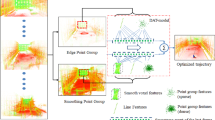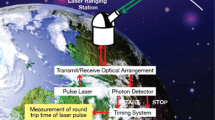Abstract.
A wide-angle airborne laser ranging system has been developed for the determination of relative heights of ground-based benchmarks in regional-scale networks (typically 100 laser reflectors spread over 100 km2). A first prototype demonstrated a 1–2 mm accuracy in radial distance measurement in a ground-based experiment in 1995. The first aircraft experiment was conducted in 1998, over a small area (1 km2) equipped with a network of 64 benchmarks. The instrument was modified before that experiment, in order to minimize echo superimposition due to the high density of benchmarks. New data processing algorithms have been developed, for the deconvolution of strongly overlapped echoes and a high a priori uncertainty in the aircraft flight path, and for the estimation of benchmark coordinates. A special methodology has been developed for the parameterization of these algorithms and of outlier detection tests. From a total of 2×104 pseudo-range measurements, that have been acquired from two flights composed of 30 legs each, only 3×103 remain after outlier detection. A positioning accuracy of 1.5 cm in the vertical coordinate (2.1 cm in the difference between the two flights) has been achieved. It is shown that the errors are normally distributed, with a nearly zero mean, and are consistent with the a posteriori uncertainty. It is also shown that the accuracy is limited mainly by the sensitivity of the photodetector used for this experiment (due to reduced response time). Another limiting factor is the effect of aircraft attitude changes during the measurements, which produces additional uncertainties in absolute distance measurements. It is planned to test new photodetectors with high internal gains. These should provide, in future experiments with smaller benchmark density, an improvement in signal-to-noise ratio of a factor of 5–10, leading to sub-centimeter vertical positioning accuracy.
Similar content being viewed by others
Author information
Authors and Affiliations
Additional information
Received: 19 June 2001 / Accepted: 3 January 2002
Rights and permissions
About this article
Cite this article
Bock, O., Thom, C. Wide-angle airborne laser range data analysis for relative height determination of ground-based benchmarks. Journal of Geodesy 76, 323–333 (2002). https://doi.org/10.1007/s00190-002-0250-0
Issue Date:
DOI: https://doi.org/10.1007/s00190-002-0250-0




